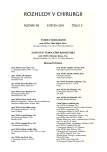Šmíd D., Novák P., Liška V., Třeška V.: Pilonidal Sinus – Surgical Management at Our Surgical Clinic
Authors:
D. Šmíd; P. Novák; V. Liška; V. Třeška
Authors‘ workplace:
Chirurgická klinika FN a LF UK v Plzni, přednosta: prof. MUDr. Vladislav Třeška, DrSc.
Published in:
Rozhl. Chir., 2011, roč. 90, č. 5, s. 301-305.
Category:
Monothematic special - Original
Overview
Introduction:
pilonidal sinus disease is a benign disease with incidence 26 cases per 100 thousands inhabitants each year. The origin of this disease is in sacrococcygeal region with maximum between 15th and 25th year of life. Males suffer from pilonidal sinus disease most often. The synonym of this disease is Jeep’s disease and originate in Second World War. We distinguish acute and chronic phase of this disease. The acute phase is characterized by presence of abscess whereas the chronic phase is featured by intermittently secreting fistula. Malignant reversion is described at chronic phase in 0.1%.
Methods:
We performed retrospective study of our cohort of 53 patients that undewent radical surgical treatment at our department between September 1st 2006 and December 31st 2009.
Results:
We evaluated 39 patients that were controlled repetitively after operation. Males were in majority. The median of age was 24 years. 38 patients underwent the incision for abscess in preoperative period. The intermittently secreting fistula was diagnosed at 46 patients at the time of operation. 41% patients suffered from wound infections and 56% from dehiscence of wound (7 patients with partial dehiscence) after radical excision. We used 5 modifications of wound closure after radical excision.
Discussion:
The choice of adequate method of wound closure after excision of pilonidal sinus was, is and will be discussed among experts. We could find many types of methods of wound closure including plastic with flaps in the scientific literature. In our country there is preferred more primary wound closure than plastic with flap. Our results are comparable with the previously published results.
Conclusion:
The treatment of pilonidal sinus has to be radical. We can conclude that usage of our technique of underlaid sutures decreases the prevalence of postoperative infection and risk of wound dehiscence. The proper types of technique of wound closure could not be evaluated with statistical signifikance because of small number of patients in our kohort.
Key words:
pilonidal disease – surgical treatment – closed excision
Sources
1. el-Khadrawy, O., Ismail, K. Outcome of the rhomboid flap for recurrent pilonidal disease. Worl journal of surgery, 2009, 33(5): 1069.
2. Eftahia, M., Abacrian, H. The dilema of pilonidal disease. Diseases of colon and rectum, 1977, 20: 279–298
3. Mohamad, A. Karydakis flap operation for chronic pilonidal sinus. Pakistan journal of surgery, 2007, volume 23, 1: 65–69.
4. Garden, J. O., Bradbury, A. W., Forsythe, J., Parks, R. W. Principle and practise of surgery. Elsevier, Edinburg, 2007, 322–338.
5. Grewe, E. H., Kremer, K. Atlas chirurgických operací. Grada, Praha, 1993, 713–714.
6. Kayaalp, C., Aydin, C. Review of pnenol treatment in sacrococcygeal pilonidal disease. Techniques in Coloproctology, 2009, 13:189–193.
7. Malek, M. M., Emanuel, O. M., Divino, M. C. Malignant degeneration of pilonidal disease in an immunosuppressed patien: report of a case and review of the literature. Diseases of colon and rectum, 2007, 50: 1475–1477.
8. Arda, I. S., Güney, L. H., Semvis, S., Hicsönen, A. Hight body mass Index as a possible risk factor for pilonidal sinus disease in adolescent. World journal of surgery, 2005, 29: 469–471.
9. Mentes, O., Akbulunt, M., Bagci, M. Verrucous carcinoma arising in a sacrococcygeal pilonidal sinus tract: report of a case. Langenbeck‘s archives of surgery, 2008, 393: 111–114.
10. Bree, E., Zoetmulder, F. A., Christodoulakis, M., Aleman, B. M., Tsiftis, D. D. Treatment of malignancy arising in pilonidal disease. Annals of surgical oncology, 2001, 102: 60–64.
11. Pekmezci, S., Hiz, M., Saribeyolu, K., Akbilen, D., Kapan, M., Nasirov, C., Tasci, H. Malignant degeneration: an anusual complication of ilonidal sinus disease. Europian journal of surgery, 2001, 167: 475–477.
12. Gips, M., Melki, Y., Salem, L., Weil, R., Sulkes, J. Minimal surgery for pilonidal disease using trephines: Description of a new technique and long term outcomes in 1358 patients. Diseases of colon and rectum, 2008, 51: 1656–1663.
13. Holmebakk, T., Nesbakken, A. Surgery for pilonidal disease. Scandinavian journal of surgery, 2005, 94: 43–46.
14. Soll, Ch., Hhnlosser, D., Dindo, D., Clavien, P. A., Hetzer, F. A novel approach for treatment of sacrococcygeal liponidal sinus: less is more. Journal of colorectal diseases, 2008, 32: 177–180.
15. Fazili, F., Fawzi, H., Parvez, T. Surgical managment of pilonidal disease: our experience. JK-Practicioner, 2004, 1: 44–48.
16. Petersen, S., Aumann, G., Kramer, A., Doll, D., Sailer, M., Hellmich, G. Short-term results of Karydakis flap for pilonidal sinus dinase. Tech Coloproctol., 2007, 11: 235–240.
17. Mentes, O., Bagci, M., Bilgin, T., Ozgul, O., Ozdemir, M. Limbegr flap procedur efor pilonidal dinase: results of 353 patients. Langenbecks Arc. Surg., 2008, 393: 185–189.
18. Beck, et. al. The ASCRS manual of colon and rectal Sumery. Springer Science + Busness media 2009, Pilonidal disease and hidradenitis suppurativa, 323–338.
19. Hoch, J., Leffler, J., a kol. Speciální chirurgie. Maxdorf, 2001, 109–113.
20. Chudáčková, E., Geigrová, L., Hrabák, J., Bergerová, T., Liška, V., Scharfen, J. Seven isolates of Actinomyces turicensis from patiens with surgical infection of anogenital area in a Czech hospital. J. Clin. Microbiol., 2010, 48: 2660–2661.
Labels
Surgery Orthopaedics Trauma surgeryArticle was published in
Perspectives in Surgery

2011 Issue 5
Most read in this issue
- Šmíd D., Novák P., Liška V., Třeška V.: Pilonidal Sinus – Surgical Management at Our Surgical Clinic
- Ňaršanská A., Třeška V., Mírka H., Mukenšnabl P., Chlumská A.: Caroli Disease – Dilatation of Intrahepatic Bile Ducts
- Hrabálek L., Starý M., Rosík S., Wanek T.: Surgery for Symptomatic Vertebral Hemangiomas
- Šafránek J., Špidlen V., Vodička J.: Mediastinal Cysts, Surgical Management
